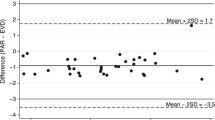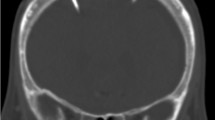Abstract
Purpose
To evaluate the in vivo accuracy of the new Pressio® device for intraparenchymal monitoring of intracranial pressure (ICP) versus the Codman® device and intraventricular measurement external ventricular drainage (EVD).
Methods
Data were collected retrospectively for 30 consecutive patients admitted into a 25-bed neurosurgical intensive care unit of a university hospital between January and December 2009. Patients received both intraventricular and intraparenchymal ICP monitoring with Pressio® (n = 15) or Codman® (n = 15).
Results
We obtained 3,089 data points from the 30 patients. Mean difference between intraparenchymal and EVD pressure (bias) was −0.6 mmHg, and limits of agreement (1.96 SD of the bias) were −8.1 to 6.9 mmHg with Pressio® and 0.3 mmHg with limits of agreement of −6.7 to 7.1 mmHg with Codman® (NS). The temporal difference was −0.7 ± 1.6 mmHg/100 h of monitoring with Pressio® and 0.1 ± 1.6 mmHg/100 h of monitoring with Codman® over the study period (NS).
Conclusions
Intraparenchymal pressure measured with both transducers approximates intraventricular cerebrospinal fluid pressure with an accuracy of ±7 mmHg.


Similar content being viewed by others
References
Bratton SL, Chestnut RM, Ghajar J, McConnell Hammond FF, Harris OA, Hartl R, Manley GT, Nemecek A, Newell DW, Rosenthal G, Schouten J, Shutter L, Timmons SD, Ullman JS, Videtta W, Wilberger JE, Wright DW (2007) Guidelines for the management of severe traumatic brain injury. VIII. Intracranial pressure thresholds. J Neurotrauma 24(Suppl 1):S55–S58
Stocchetti N, Zanaboni C, Colombo A, Citerio G, Beretta L, Ghisoni L, Zanier ER, Canavesi K (2008) Refractory intracranial hypertension and “second-tier” therapies in traumatic brain injury. Intensive Care Med 34:461–467
Andrews PJ, Citerio G, Longhi L, Polderman K, Sahuquillo J, Vajkoczy P (2008) NICEM consensus on neurological monitoring in acute neurological disease. Intensive Care Med 34:1362–1370
Bratton SL, Chestnut RM, Ghajar J, McConnell Hammond FF, Harris OA, Hartl R, Manley GT, Nemecek A, Newell DW, Rosenthal G, Schouten J, Shutter L, Timmons SD, Ullman JS, Videtta W, Wilberger JE, Wright DW (2007) Guidelines for the management of severe traumatic brain injury. VII. Intracranial pressure monitoring technology. J Neurotrauma 24(Suppl 1):S45–S54
Koskinen LO, Olivecrona M (2005) Clinical experience with the intraparenchymal intracranial pressure monitoring Codman MicroSensor system. Neurosurgery 56:693–698 discussion 693–698
Poca MA, Sahuquillo J, Arribas M, Baguena M, Amoros S, Rubio E (2002) Fiberoptic intraparenchymal brain pressure monitoring with the Camino V420 monitor: reflections on our experience in 163 severely head-injured patients. J Neurotrauma 19:439–448
Allin D, Czosnyka M, Czosnyka Z (2008) Laboratory testing of the Pressio intracranial pressure monitor. Neurosurgery 62:1158–1161 discussion 1161
Lescot T, Abdennour L, Boch AL, Puybasset L (2008) Treatment of intracranial hypertension. Curr Opin Crit Care 14:129–134
Shore PM, Thomas NJ, Clark RS, Adelson PD, Wisniewski SR, Janesko KL, Bayir H, Jackson EK, Kochanek PM (2004) Continuous versus intermittent cerebrospinal fluid drainage after severe traumatic brain injury in children: effect on biochemical markers. J Neurotrauma 21:1113–1122
Korinek AM, Reina M, Boch AL, Rivera AO, De Bels D, Puybasset L (2005) Prevention of external ventricular drain-related ventriculitis. Acta Neurochir (Wien) 147:39–45 discussion 45–36
Bland JM, Altman DG (1986) Statistical methods for assessing agreement between two methods of clinical measurement. Lancet 1:307–310
Bland JM, Altman DG (2007) Agreement between methods of measurement with multiple observations per individual. J Biopharm Stat 17:571–582
Gopinath SP, Robertson CS, Contant CF, Narayan RK, Grossman RG (1995) Clinical evaluation of a miniature strain-gauge transducer for monitoring intracranial pressure. Neurosurgery 36:1137–1140 discussion 1140–1131
Courtois M, Fattal PG, Kovacs SJ Jr, Tiefenbrunn AJ, Ludbrook PA (1995) Anatomically and physiologically based reference level for measurement of intracardiac pressures. Circulation 92:1994–2000
Lescot T, Bonnet MP, Zouaoui A, Muller JC, Fetita C, Coriat P, Puybasset L (2005) A quantitative computed tomography assessment of brain weight, volume, and specific gravity in severe head trauma. Intensive Care Med 31:1042–1050
Schaller B, Graf R (2005) Different compartments of intracranial pressure and its relationship to cerebral blood flow. J trauma 59:1521–1531
Al-Tamimi YZ, Helmy A, Bavetta S, Price SJ (2009) Assessment of zero drift in the Codman intracranial pressure monitor: a study from 2 neurointensive care units. Neurosurgery 64:94–98 discussion 98-99
Conflict of interest
The authors have no personal financial interest in any of the materials or devices described in this noncommissioned study.
Author information
Authors and Affiliations
Corresponding author
Rights and permissions
About this article
Cite this article
Lescot, T., Reina, V., Le Manach, Y. et al. In vivo accuracy of two intraparenchymal intracranial pressure monitors. Intensive Care Med 37, 875–879 (2011). https://doi.org/10.1007/s00134-011-2182-8
Received:
Accepted:
Published:
Issue Date:
DOI: https://doi.org/10.1007/s00134-011-2182-8




